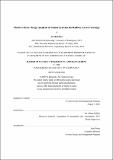Multi-criteria design analysis of sensor systems for railway level crossings
Author(s)
Miyashita, Yu, S.M. Massachusetts Institute of Technology.
Download1263245039-MIT.pdf (5.864Mb)
Other Contributors
Massachusetts Institute of Technology. Engineering and Management Program.
System Design and Management Program.
Terms of use
Metadata
Show full item recordAbstract
The prevention of railway accidents on level crossings is of critical importance for railway companies because of their high frequency and considerable severity. As a countermeasure against the accidents, obstacle detection systems are widely installed and used in a large number of level crossings in Japan. However, current obstacle detection systems can typically detect only automobiles and not pedestrians and can be improved in accuracy and reliability performance. This thesis develops a method for effectively determining the best combinations of sensors that can detect human-sized objects on railway level crossings with the highest utility and least costs. The method assesses combinations of up to three sensor technologies such as LIDAR, stereo camera, and millimeter laser radar. We evaluate each sensor and find the best combination of multiple sensors according to a set of performance criteria. The analysis was conducted using empirical data of 1,800 high-risk level crossings in Japan. The results show that if uniform emphasis is given to criteria related to safety and stability as well as when emphasis is solely on safety or solely on stability, in all cases the highest utility at lowest cost is provided by wide lens stereo cameras. The utility increases by 36% if a combination of stereo cameras and LIDARs are used, however the cost of such two-sensor systems increases by four folds. A system safety analysis was also performed, and transportation safety from the viewpoint of not only sensors but also the larger system that includes humans was analyzed. Using the Systems Theoretic Process Analysis, we find that the system safety is highly dependent on both human factors and system structure. The analysis results show that automating the emergency braking system can be an effective countermeasure against railway accidents caused by humans. Overall, the analysis tool developed in this work allows for analysis and simulations to be easily updated with new performance specifications of sensors and utility functions. The tool can be used for rapidly analyzing new systems when new types of sensors become available, costs change, or new sets of criteria for system performance (expressed as a utility) need to be assessed.
Description
Thesis: S.M. in Engineering and Management, Massachusetts Institute of Technology, System Design and Management Program, September, 2020 Cataloged from the official version of thesis. Includes bibliographical references (pages 100-102).
Date issued
2020Department
Massachusetts Institute of Technology. Engineering and Management ProgramPublisher
Massachusetts Institute of Technology
Keywords
Engineering and Management Program., System Design and Management Program.